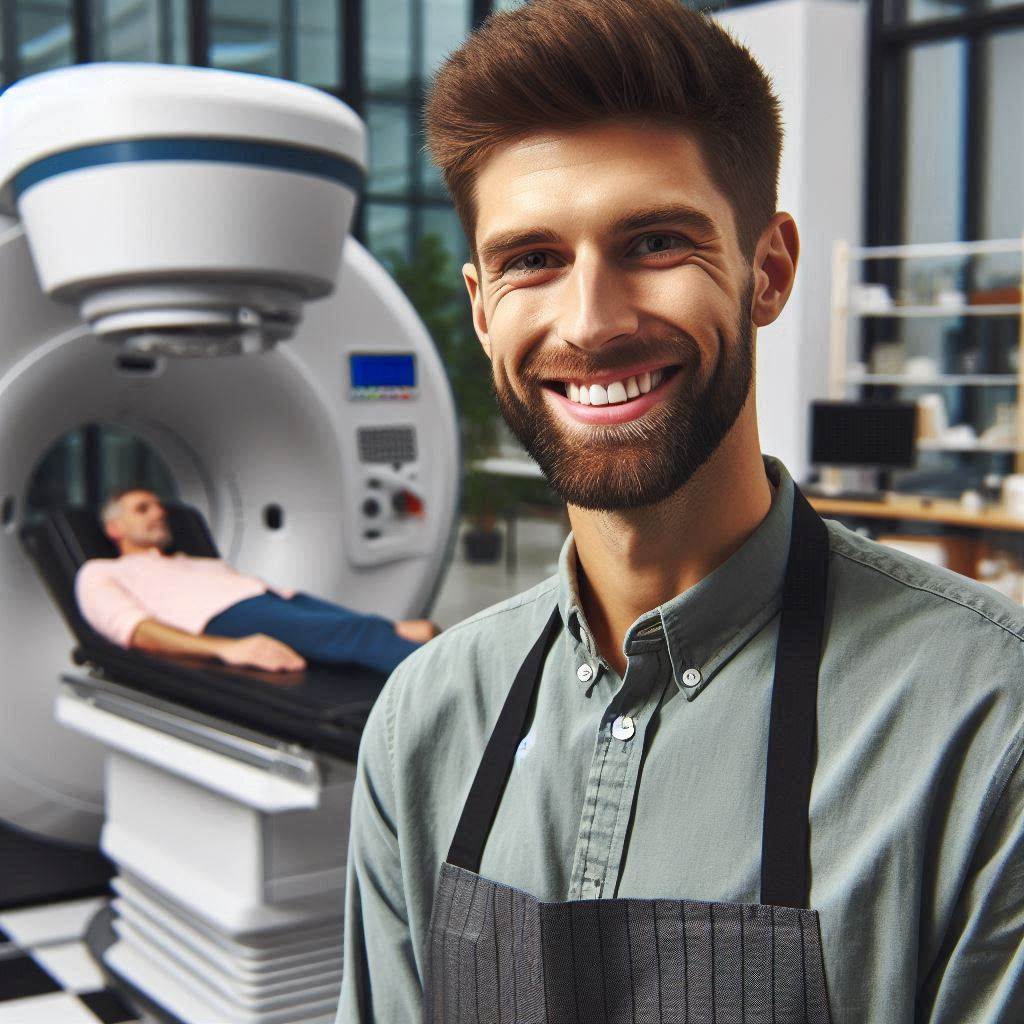Introduction
Radiation therapy is a crucial treatment method for cancer patients, and radiation therapists play a vital role in delivering this therapy effectively.
Having the right equipment is essential for radiation therapists to perform their job with precision and accuracy.
In this blog post, we will discuss the key equipment that every radiation therapist should have in their arsenal.
A linear accelerator is the cornerstone of radiation therapy equipment.
It delivers high-energy x-rays or electrons to target cancer cells while minimizing damage to surrounding healthy tissues.
A CT simulator is used to precisely define the treatment area before radiation therapy begins.
It helps radiation therapists create a customized treatment plan for each patient.
Positioning devices such as immobilization devices and positioning lasers are crucial for ensuring that patients are in the correct position for treatment delivery.
They help maintain consistency and accuracy throughout the treatment process.
A record and verify system is used to double-check treatment parameters before each session.
This system enhances safety and minimizes the risk of errors during radiation therapy.
Dosimetry equipment is essential for measuring the radiation dose delivered to the patient.
This ensures that the prescribed dose is accurate and that the treatment is delivered as planned.
By having the right equipment, radiation therapists can provide high-quality care to their patients and achieve optimal treatment outcomes.
Linear Accelerator
When it comes to radiation therapy, the linear accelerator is the backbone of delivering high-energy radiation to target tumors with precision and accuracy.
It plays a crucial role in the treatment process, and radiation therapists must have a thorough understanding of its features, functionalities, and safety measures to ensure the best outcomes for patients.
Importance of the Linear Accelerator
- Delivers high-energy radiation to target tumors
- Ensures precise and accurate treatment delivery
- Helps minimize radiation exposure to surrounding healthy tissues
- Plays a key role in the effectiveness of radiation therapy
Without the linear accelerator, radiation therapists would not be able to administer the necessary radiation doses to target tumors effectively.
Its advanced technology allows for customized treatment plans that are tailored to each patient’s specific needs, ensuring optimal treatment outcomes.
Features and Functionalities of a Modern Linear Accelerator
- Image-guided radiation therapy (IGRT) for precise tumor targeting
- Volumetric modulated arc therapy (VMAT) for rapid treatment delivery
- Cone-beam computed tomography (CBCT) for accurate treatment positioning
- Respiratory gating for tracking tumor movement during treatment
Modern linear accelerators are equipped with state-of-the-art technologies that enhance treatment accuracy, efficiency, and patient safety.
These features allow radiation therapists to deliver targeted radiation doses while minimizing side effects and maximizing tumor control.
Transform Your Career Today
Unlock a personalized career strategy that drives real results. Get tailored advice and a roadmap designed just for you.
Start NowSafety Measures Associated with Operating the Linear Accelerator
- Regular maintenance and quality assurance checks
- Proper training and certification for radiation therapists
- Adherence to strict safety protocols and procedures
- Monitoring patient positioning and treatment delivery
Operating a linear accelerator requires strict adherence to safety measures to minimize the risk of errors or accidents during treatment.
Radiation therapists undergo extensive training to ensure they can operate the machine safely and effectively, following established protocols to protect both themselves and their patients.
In essence, the linear accelerator is an essential piece of equipment for radiation therapists, enabling them to deliver precise and effective radiation therapy treatments to target tumors.
Understanding its features, functionalities, and safety measures is vital for ensuring successful treatment outcomes and patient care.
Read: Radiation Therapy for Cancer Treatment Explained
Radiation Shielding
When it comes to radiation therapy rooms, one of the essential equipment that is vital for the safety of both patients and staff is radiation shielding.
Types of Radiation Shielding
- Lead Shielding: Lead is the most common material used for radiation shielding due to its high density and ability to absorb radiation.
- Concrete Shielding: Concrete is also used as a cost-effective option for radiation shielding, especially in the construction of radiation therapy rooms.
- Barium Sulfate Shielding: Barium sulfate is used in some cases for its radiation attenuation properties, particularly in imaging rooms.
- Tungsten Alloy Shielding: Tungsten alloy is sometimes used for radiation shielding in high-energy radiation therapy applications.
Purpose of Radiation Shielding
The primary purpose of radiation shielding in radiation therapy rooms is to protect both patients and staff from unnecessary exposure to radiation.
- Shielding helps minimize the scatter radiation that can lead to unwanted dose to healthy tissues and organs.
- It also helps reduce radiation exposure to healthcare workers who are in close proximity to the radiation source during treatment.
- By using the appropriate shielding materials, the level of radiation exposure can be kept within safe limits as per regulatory guidelines.
Regulations and Guidelines
There are strict regulations and guidelines that healthcare facilities must follow when it comes to installing radiation shielding in radiation therapy rooms.
- The American Association of Physicists in Medicine (AAPM) provides guidelines for the design and construction of radiation therapy facilities.
- The National Council on Radiation Protection and Measurements (NCRP) also offers recommendations for radiation shielding requirements in healthcare settings.
- Regulatory bodies like the Nuclear Regulatory Commission (NRC) set standards for radiation protection to ensure the safety of patients and healthcare workers.
Radiation shielding protects everyone in radiation therapy rooms. It ensures safety and well-being during treatments.
Read: Pros and Cons of a Career in Radiation Therapy
Dosimetry Equipment
With the advancement in technology, dosimetry equipment has become an essential component in radiation therapy.
Dosimetry equipment plays a crucial role in measuring the radiation dose delivered to patients accurately.
It ensures that the treatment is administered safely and effectively.
Definition and Role
Dosimetry equipment refers to devices used to measure radiation doses absorbed by patients during treatment.
These measurements are crucial in ensuring that patients receive the prescribed dose of radiation for their specific condition.
Types of Dosimeters
- Thermoluminescent Dosimeters (TLDs): TLDs are small crystals that can detect and measure radiation exposure.
They are widely used in radiation therapy to monitor dose delivery accurately. - Optically Stimulated Luminescence Dosimeters (OSLDs): OSLDs are similar to TLDs but offer faster readout capabilities.
They are commonly used in quality assurance checks for radiation therapy equipment. - Film Dosimetry: Film dosimetry involves the use of radiographic films to visualize the distribution of radiation dose in a patient’s body.
It provides detailed information about dose distribution. - Ionization Chamber: Ionization chambers are used to measure the electrical charge produced by ionizing radiation.
They are highly accurate and are used as reference dosimeters in radiation therapy.
Importance of Dosimetry Equipment
Dosimetry equipment plays a vital role in ensuring the accuracy and precision of radiation therapy treatments.
Dosimeters monitor radiation dose delivered to patients. They help radiation therapists confirm the treatment plan’s execution.
Dosimeters identify deviations from the planned dose distribution. They enable immediate adjustments to ensure patient safety.
This real-time feedback is crucial in minimizing the risk of over or under-dosing.
Showcase Your Business Today
Reach thousands of readers actively exploring professional services. Publish your business profile and grow your audience now.
Publish NowIn addition, dosimetry equipment is essential for quality assurance purposes.
By regularly calibrating and checking the dosimeters, radiation therapists can maintain the accuracy of their treatment delivery systems and ensure consistent and reliable results for patients.
Overall, dosimetry equipment is a critical component of radiation therapy that helps ensure the safe and effective delivery of treatments to patients.
It is indispensable in the modern practice of oncology and plays a key role in improving patient outcomes and treatment efficacy.
Read: Continuing Education for Radiation Therapists

Treatment Planning Software
Treatment planning software plays a crucial role in designing personalized radiation therapy plans for patients.
Modern treatment planning software comes equipped with advanced features to help radiation therapists optimize treatment outcomes.
Training and proficiency in using treatment planning software effectively are essential for radiation therapists.
Importance of Treatment Planning Software
Treatment planning software allows radiation therapists to create customized treatment plans based on individual patient needs.
It helps in accurately calculating the dosage of radiation required for each patient, ensuring precise treatment delivery.
The software enables visualization of the treatment plan in 3D, aiding in targeting the tumor while minimizing radiation exposure to surrounding healthy tissues.
By allowing for dose optimization and plan evaluation, treatment planning software helps in achieving better treatment outcomes for patients.
Integration with imaging modalities and data management systems enhances efficiency and accuracy in treatment planning.
Collaboration among radiation therapists, medical physicists, and oncologists is facilitated through the use of treatment planning software.
Continuous updates and improvements in treatment planning software ensure that therapists have access to the latest tools and techniques.
Quality assurance checks within the software help in maintaining the accuracy and safety of radiation therapy treatments.
Timely updates and maintenance of treatment planning software are crucial to ensure optimal performance and reliability in clinical practice.
The ability to simulate various treatment scenarios and evaluate alternative plans makes treatment planning software an invaluable tool for radiation therapists.
Features of Modern Treatment Planning Software
Advanced algorithms for dose calculation and optimization ensure precise and effective treatment delivery.
Integration with imaging systems allows for seamless transfer of patient data and images, improving workflow efficiency.
Automated contouring tools aid in delineating target volumes and critical structures, reducing the margin of error in treatment planning.
Dose-volume histograms and other visualization tools help in assessing the dose distribution and evaluating plan quality.
Plan comparison and dose summation features enable therapists to compare different treatment plans and evaluate cumulative doses.
Adaptive planning capabilities in modern treatment planning software allow for adjustments during the course of treatment to account for changes in the patient’s condition.
Training and Proficiency in Using Treatment Planning Software
Proper training in treatment planning software is essential for radiation therapists to harness its full potential.
Ongoing education and proficiency testing ensure that therapists stay updated on the latest advancements in treatment planning software.
Hands-on experience and practical training are necessary to develop proficiency in using treatment planning software effectively.
Collaboration with medical physicists and other members of the treatment team is crucial for optimizing treatment plans using software tools.
Continuous learning and skill development in treatment planning software enhance the quality of care provided to cancer patients.
Read: Effective Communication Skills for Home Health Aides
Image-Guided Radiation Therapy (IGRT) Equipment
IGRT is a cutting-edge technology that allows radiation therapists to target tumors with pinpoint accuracy.
Different Types of Imaging Equipment used in IGRT
- CT Scanners
- MRI Machines
- PET Scanners
- Cone-beam CT (CBCT)
- Ultrasound Machines
Benefits of IGRT Equipment in Improving Treatment Accuracy and Reducing Side Effects
- Enhanced Precision: IGRT helps ensure that radiation is delivered directly to the tumor, minimizing damage to surrounding healthy tissues.
- Real-Time Monitoring: IGRT allows therapists to track any changes in the tumor’s position during treatment, adjusting the radiation beams accordingly.
- Customized Treatment Plans: By using IGRT equipment, therapists can tailor treatment plans to each patient’s unique anatomy and tumor characteristics.
- Reduced Side Effects: The high level of precision offered by IGRT equipment helps minimize side effects, improving the overall quality of life for patients.
- Increased Treatment Success: With IGRT, therapists can deliver higher doses of radiation to the tumor while sparing healthy tissues, leading to improved treatment outcomes.
Personal Protective Equipment (PPE)
Importance of wearing appropriate PPE
Radiation therapists must prioritize safety by wearing appropriate personal protective equipment (PPE).
This includes lead aprons and gloves designed to shield from harmful radiation.
Wearing PPE significantly reduces exposure, protecting therapists from potential health risks.
The importance of PPE in radiation therapy cannot be overstated; it ensures safety and minimizes radiation-related injuries.
Guidelines for selecting and using PPE to ensure maximum protection for radiation therapists
Selecting and using PPE correctly is crucial. Guidelines recommend choosing PPE based on the type and level of radiation exposure.
Lead aprons should cover vital organs to provide maximum protection. Gloves must fit properly to avoid any gaps in coverage.
Following these guidelines ensures therapists remain safe while performing their duties.
Significance of regular maintenance and proper storage of PPE to prolong its effectiveness
Regular maintenance and proper storage of PPE are essential for its effectiveness. PPE should be inspected frequently for any signs of wear or damage.
Damaged PPE can compromise protection, so it must be repaired or replaced promptly.
Showcase Your Business Today
Reach thousands of readers actively exploring professional services. Publish your business profile and grow your audience now.
Publish NowProper storage, such as hanging lead aprons to prevent creases, helps maintain their protective qualities.
Well-maintained PPE lasts longer and provides consistent protection.
In a nutshell, PPE is vital for radiation therapists. Wearing the right PPE, adhering to guidelines for its use, and maintaining it properly ensure maximum protection.
Radiation therapists must prioritize their safety by understanding and implementing these practices.
Brachytherapy Equipment
Brachytherapy is a form of radiation therapy where radioactive sources are placed directly into or next to the tumor. It is used to treat various types of cancer.
Types of Brachytherapy Equipment
- Implantable Seeds: Small radioactive seeds are implanted directly into the tumor.
- Catheters: Flexible tubes used to deliver radioactive sources to the affected area.
- Applicators: Special devices used to position and deliver radiation to specific areas of the body.
Procedures and Safety Measures
- Patient Preparation: Ensure the patient understands the procedure and potential side effects.
- Equipment Setup: Verify proper functioning of all brachytherapy equipment before treatment.
- Treatment Delivery: Carefully position and secure the radioactive sources in the patient’s body.
- Monitoring: Regularly monitor the patient during treatment to ensure proper radiation delivery.
- Quality Assurance: Perform quality checks to maintain the accuracy and safety of brachytherapy treatments.
- Patient Education: Provide clear instructions on post-treatment care and follow-up appointments.
Conclusion
After discussing the essential equipment for radiation therapists, it is clear that these professionals rely on a variety of tools to effectively perform their job.
First and foremost, a linear accelerator is crucial for delivering radiation therapy to patients.
This high-energy machine produces beams of radiation that are used to target cancer cells with precision.
Additionally, specialized treatment planning systems are necessary to create customized radiation therapy plans for each patient.
These systems help radiation therapists determine the optimal dosage and angles for treatment delivery.
Radiation therapists also require immobilization devices to ensure patients are in the correct position during treatment.
These devices help minimize movement and ensure accuracy in targeting the radiation beams.
Furthermore, imaging equipment such as CT scanners and MRI machines play a vital role in the planning and monitoring of radiation therapy treatments.
These imaging tools provide detailed images of the patient’s anatomy, allowing for precise treatment delivery.
Investing in high-quality equipment is essential for radiation therapists to provide safe and effective care to their patients.
Proper maintenance and regular training on equipment usage are crucial to ensure optimal performance and patient safety.
Continuous professional development is encouraged to stay updated on advancements in radiation therapy equipment.
By staying informed about new technologies and techniques, radiation therapists can improve patient outcomes and enhance their skills in delivering quality care.
[E-Books for Sale]
The Big Book of 500 High-Paying Jobs in America: Unlock Your Earning Potential
$19.99 • 500 High-Paying Jobs • 330 pages
Explore 500 high-paying jobs in America and learn how to boost your career, earn more, and achieve success!
See All 500 High-Paying Jobs of this E-Book
1001 Professions Without a Degree: High-Paying American Jobs You Can Start Now
$19.99 • 1001 Professions Without a Degree • 174 pages
Discover 1001 high-paying jobs without a degree! Unlock career tips, skills, and success strategies for just $19.99!




